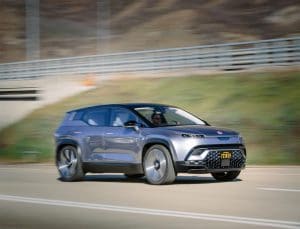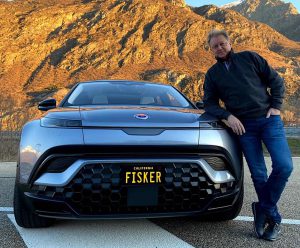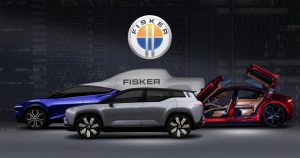Fisker Inc., the California-based EV startup hoping to challenge segment leader Tesla, has signed a preliminary deal meant to get its first product, the Fisker Ocean SUV, into production late next year, TheDetroitBureau.com has learned.
Fisker, which also is in the process of going public, will announce no later than Monday that it has signed a memorandum of understanding with Magna Steyr Fahrzeugtechnik to have the Ocean produced at its factory in Graz, Austria. Magna Steyr may later add production capacity for Fisker in both North America and China, according to several well-placed insiders close to the negotiations.
This puts Fisker “on track for Q4 2022” to start rolling out pilot vehicles at the Graz plant, said one source. That would be in line with the timing laid out by the automaker’s founder, Henrik Fisker, in a conversation with TheDetroitBureau.com last month. The one-time Aston Martin designer said the goal would be to launch retail sales of the Ocean in late 2022 or early 2023.
(Fisker confirms four models in the works by 2025 — including all-electric pickup truck.)
Fisker Inc. is the second effort by the Danish-born entrepreneur to launch his own company. His Fisker Automotive introduced its Karma plug-in hybrid a decade ago, but the venture ran into financial and manufacturing issues, going bankrupt in 2013. Henrik Fisker announced plans to get back into business in 2016, showing off a prototype sports sedan dubbed EMotion. The startup has since shifted focus to an SUV, a move matching the broader evolution of the global auto industry.
The Ocean is meant to target the likes of the Tesla Model Y, as well as upcoming battery-electric SUVs like the Ford Mustang Mach-E and Volkswagen ID.4. A prototype was unveiled at the Consumer Electronics Show in Las Vegas in January.
In line with Henrik Fisker’s background, the company is focusing primarily on design and plans to partner with other sources for both the underlying platform and powertrain technologies, as well as for manufacturing.
The Ocean prototype shown in Las Vegas rode on a version of VW’s MEB architecture that will underpin that company’s ID.4 model, among others. A final deal has not been struck, however, and TheDetroitBureau.com has confirmed that Fisker is still talking with two other automakers, as well as an auto supplier about possibly supplanting VW as the source of the Ocean’s platform.
Whichever wins out, the vehicle now will be assembled in Graz. Magna Steyr, a subsidiary of Canadian mega-supplier Magna International, has served as a go-to source for a number of mainstream manufacturers, including Daimler AG and Fiat Chrysler, looking to produce low-volume specialty vehicles.
(EXCLUSiVE: With IPO in sight, Fisker reveals production plans, switch to VW MEB platform.)
Magna has been interested in expanding the Austrian operation to other countries and, with Fisker, that is under discussion, the inside sources explained.
Futher details are expected to be announced as part of a proxy statement that Fisker will release today or Monday.
The startup is currently in the midst of completing a reverse merger with a special purpose acquisition company launched by the private equity giant Apollo Global Management. Such deals with SPACs, colloquially known as “blank-check companies,” have become a popular way of taking a start-up public. The deal, according to a Fisker official, could be completed sometime late this quarter or early during the fourth quarter of 2020. There has been speculation the move would value Fisker at just under $3 billion.
As Henrik Fisker learned personally during his first try at launching a car company, however, that is not nearly as much money as it might seem. A new assembly plant alone can push to $1 billion or more. And that’s why he told TheDetroitBureau.com that he plans to use a partnership strategy, rather than trying to do everything in-house as has Tesla, and as are other start-ups like Lucid and Faraday Future.
The approach may add more cost to a vehicle but it also passes off some of the risk that would come with investing in putting fixed assets into the ground. It also should help speed up the time to market, Fisker said last month. And, by working with a well-established manufacturer, he added, it could help his start-up avoid the quality problems that have continued to plague Tesla since it launched its first volume product, the Model S.
(Fisker going public on NYSE, expected to raise $1 billion.)
A Fisker spokesman could not immediately comment on the negotiations with Magna Steyr.




Would like to know when ipo stock is being offered.
Details on a stock offering have yet to be formalized. Stay tuned.
Paul E.
@ Antonio- To purchase the stock right now you purchase Spartan Energy Corp stock (SPAQ)
Listed on the NYSE.
Spartan is due to merge with Fisker by 14th February 2021.
I hope this helps?
Being a reservation holder, I expect the first U.S. production by the 1st quarter of 2022. If that is not possible then I will have to pass on this vehicle for now.
@Antonio,
Hi Antonio, Fisker is merging with a company called Spartan Energy (Spaq)
It is listed on the NYSE.
If you purchase Spartan Energy shares they will automatically convert to Fisker shares once the merger is complete.
This process is know as a reverse merger.
The merger is due to take place before or around 14th February 2021.
This information is available on the internet.
I hope this helps.
R